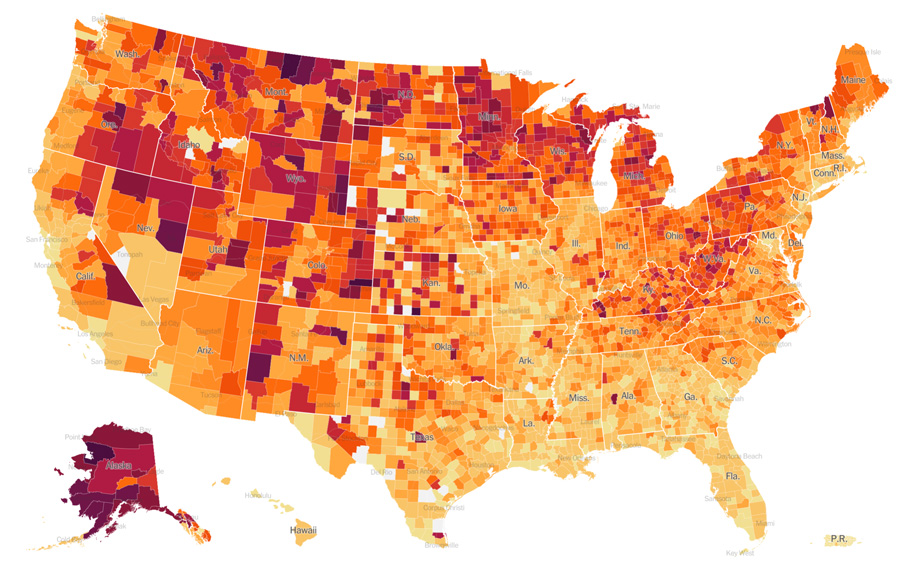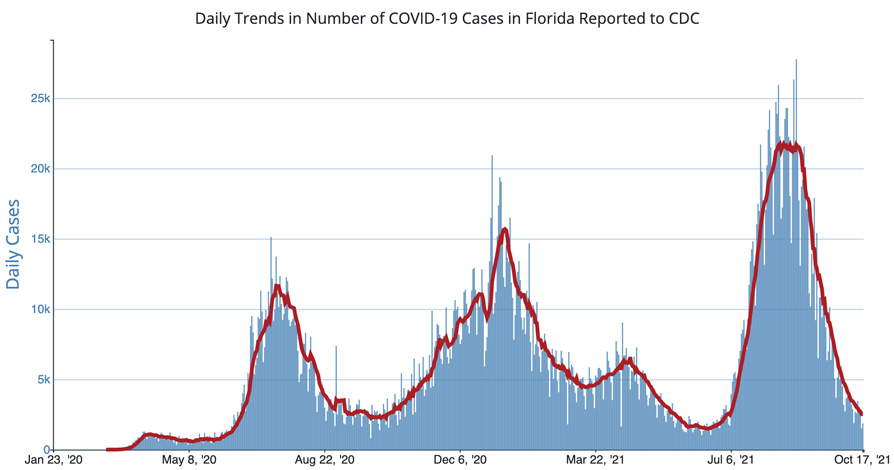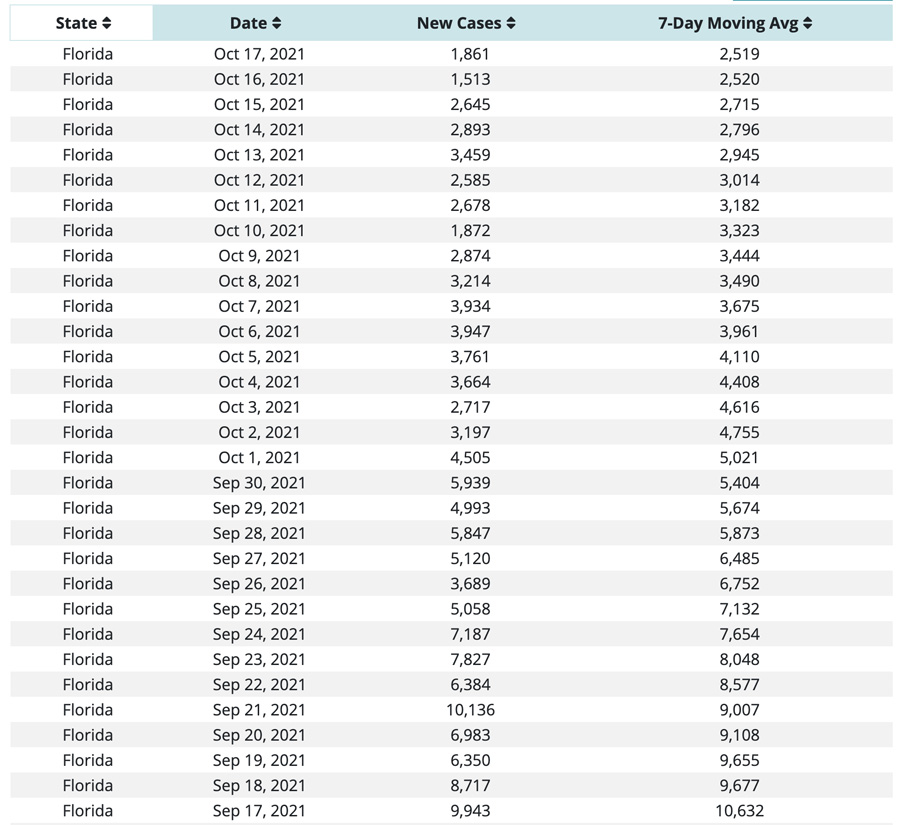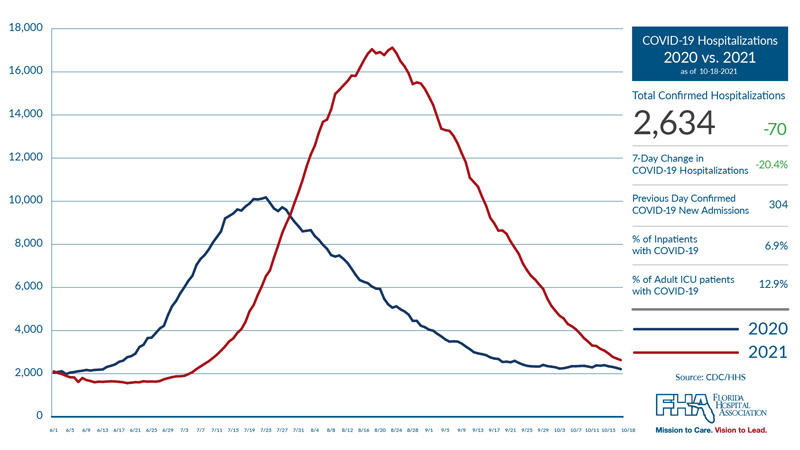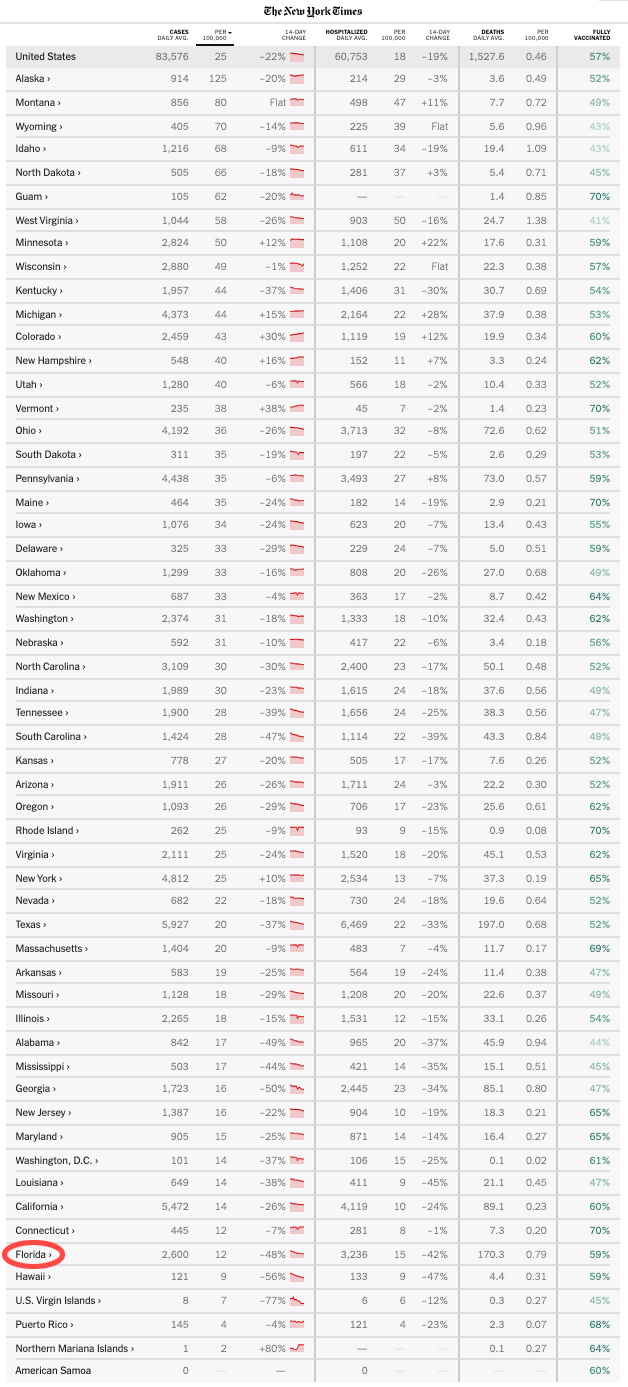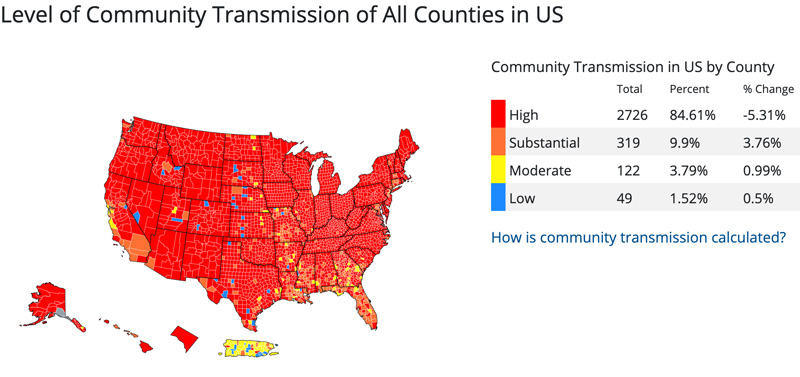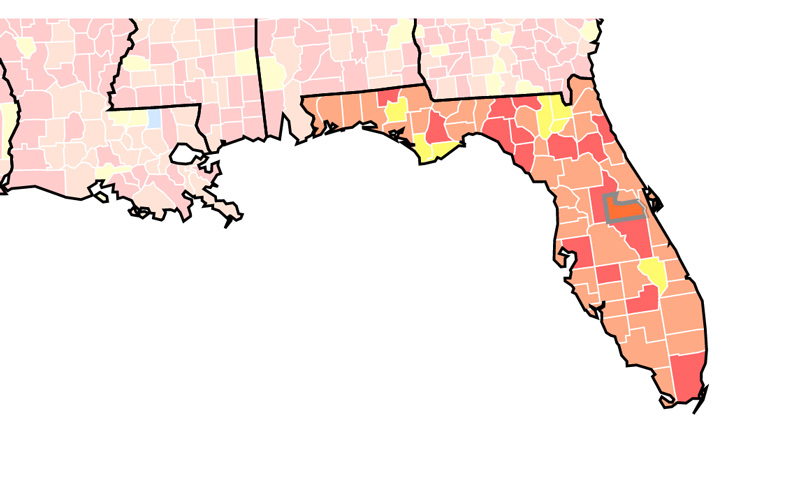COVID Report: Florida Falls to 49th in US for New Cases & OC Improves to Orange Tier
Here’s this week’s COVID-19 report with new cases, positivity, and hospitalization data from Florida and around Walt Disney World as of October 18, 2021. Plus, an update on where Orange County stands in the CDC’s Community Transmission Map, which tracks the level the numbers need to reach before Walt Disney World considers dropping indoor mask rules.
We’ll start with the latest report from the Florida Department of Health, which shows the another significant drop in new weekly cases at 19,519. This is the lowest number in the last 10 weeks, which is how long the report dates back. As a reminder, Florida topped 150,000 weekly cases for several consecutive weeks in August. In early September, weekly cases were still above 100,000.
Florida’s rolling positivity rate continues to decrease as well, down to 3.8%. That number was 4.8% last week and 6.6% the week before that. It had been in the 20% range for late July through mid-August. Positivity rates and new cases dropping in tandem indicates that Florida’s prevalence continues to decrease–good news!
This report shows new cases dropping in the last week among every age range, including among school age kids eligible for vaccinations. Inoculations continue to increase among the 12-19 age cohort (now at 55%) and every age range, but have slowed significantly from their pace during the peak of the wave.
The highest case numbers are once again occurring in age ranges between 20 and 39 years old. Over 84% of Floridians above the age of 60 are vaccinated, plus 77% of those ages 50-59. The lowest vaccination rate is among residents ages 20-29 at 54%.
Here’s a look at Florida’s daily case trend via the United States Centers for Disease Control and Prevention’s COVID Data Tracker. Per the CDC, Florida’s 1,513 new cases on Saturday is the lowest daily count since June 27, which was when cases had bottomed out over the late spring and summer, well before the most recent surge.
The state’s 7-day average of new cases stands at 2,519 as of October 17, 2021. That’s down from over 10,000 exactly one month ago. This is Florida’s lowest rolling 7-day average since July 2, which is (again) before the most recent wave began. At its current pace, Florida’s rolling average will be back to its June lows by next week.
Above is a chart of Florida’s daily case data from the CDC to put this precipitous decrease into context.
After peaking in late August, daily numbers and the moving average have been falling throughout September and October. Again, since the positivity rate is decreasing with moving case numbers, this is not a result of decreased testing. It’s also follows the visible trajectory of every past wave.
For further insight, the Florida Hospital Association continues to report a decline in new hospitalizations. The total number of hospitalizations as of yesterday is 2,634.
This number is down 20.4% week-over-week, at less than half the level of only a few weeks ago. Until early September, that number was above 15,000. At its current pace, hospitalizations will retreat to early July levels within the next couple of weeks.
Per numbers from the U.S. Department of Health and Human Services, coronavirus patients account for 5.25% of Florida’s inpatient beds (down from over 20% in August) and 12.9% of ICU beds (down from 35% in August). Both of these numbers are also significantly lower than the national average.
Despite this sharp drop in coronavirus patients, 75.77% of hospital beds in Florida are still in use (down from over 85% in August). This is likely a mix of standard procedures resuming and the reality that hospitals normally operate at relatively high capacity even under normal circumstances (although that number has dropped in recent decades per CDC data).
Deaths remain elevated, but are also well past peak. As a reminder, deaths are counted on the date they occurred rather than the date they’re reported. Additionally, it typically takes 2-3 weeks for those deaths to appear in the daily or weekly reports. This means that not only do deaths lag cases, but they are backfilled in the reporting data. It’s thus difficult to say with certainty when deaths have peaked until a month or so after the fact.
With that said, looking backwards 3 weeks shows a moving average of 201 deaths per day, which is down from ~250 only a couple of weeks before that. It appears that deaths peaked in late August/early September at around 375 per day, as mid-September deaths were down considerably–even dates that are 3-4 weeks ago after the tally should be close to finalized.
On an upbeat note, Florida now ranks 49th among states in the U.S. for average daily COVID cases per 100,000 people per data compiled by the New York Times. Florida continues to improve its standing each week, after being in the top 10 last month and holding the #1 (worst) spot for much of August when it accounted for nearly 25% of all cases in the nation at one point.
The only state with superior case numbers per capita is Hawaii, which means Florida is now #1 (best) of the contiguous states. There are still specific counties doing better, including the rural South and California’s Bay Area, but Florida as a whole is now performing incredibly well following the huge surge. Hopefully, the significant number of natural infections coupled with vaccinations form a wall of immunity that results in a less significant–or nonexistent–holiday spike in Florida.
There was no Orange County government public health briefing today with Mayor Jerry Demings and Dr. Raul Pino from the Florida Department of Health, which is honestly fine by me. These were incredibly helpful last year, this spring, and again from late July through August in gaining insight into the trajectory of the pandemic when things were bad or there’s uncertainty.
They’re less useful now when the numbers are clear and largely speak for themselves. With that said, Orange County did tweet out that the 14-day rolling positivity rate is 4.56%. This is the 7th consecutive day with the 14-day rolling average at or below 5%.
That’s significant, as this was Orange County’s target for relaxing restrictions in the spring–and Mayor Demings repeatedly stated it was the goal for this fall. What, if anything, this means in practice is unclear. Regardless, it’s another bit of good news.
With that, let’s turn to the CDC’s Community Transmission Map, which is based on positivity and incidence numbers. (I don’t know why it’s so small–I couldn’t make it any larger without losing states.) As you can see, most of the United States is still in the red tier, with the notable exception of the South that saw a spike in cases towards the end of summer.
Those counties reporting 100 cases or more cases per 100,000 residents, or that have a positivity rate of at least 10% fall into the high transmission tier. If a county has reported 50 to 100 cases per 100,000 residents over a seven-day period or has a positivity rate of 8% to 10%, it falls into the substantial transmission tier. Since late July, Orange County has been in the high transmission tier.
The good news is that Orange County just moved down to the substantial (or orange) tier, with a case rate of 94.37 per 100,000 residents and positivity rate of 4.62%. That positivity rate actually qualifies Orange County for the low tier, which is below the target to drop indoor masking. It’s the case rate that needs to fall more, and it has already been dropping by around 20-30% each week (it’s “only” down 18.63% in the last 7 days).
The CDC recommends indoor masking for the fully vaccinated only in those two tiers. The criteria for moving down to the moderate level is under 50 total new cases per 100,000 persons in the past 7 days and under 8% test positivity during the past 7 days. Low tier requires 0-10 cases per 100,000 residents and a positivity rate under 5%.
Walt Disney World and Disneyland reinstated their indoor mask rules with that CDC guidance, so it’s likely Disney won’t lift the rule until the Orange Counties qualify for the moderate level. Previously, Disney changed the rules for both Walt Disney World and Disneyland simultaneously. Anything is possible, but we’d expect the same scenario once again–especially with both coasts pretty comparable right now.
If current trends hold, Disneyland would qualify for lifting the rule first, as California’s Orange County already has a low positivity rate and is just waiting on its case rate to hit the moderate level. Orange County, CA’s current case rate is 50.19 per 100,000–so it’s likely California’s OC will qualify within a matter of days.
At the current rate of decline, Florida’s Orange County will be at or below 50 cases per 100,000 within only a few weeks, but it’s possible that the precipitous rate of decline could slow. That would put Orange County in the yellow or moderate tier just before Thanksgiving; in such a scenario, Walt Disney World might wait to lift the current mask rules until after the holiday season, waiting to see a sustained downturn throughout the United States or whether there’s another holiday spike.
Planning a Walt Disney World trip? Learn about hotels on our Walt Disney World Hotels Reviews page. For where to eat, read our Walt Disney World Restaurant Reviews. To save money on tickets or determine which type to buy, read our Tips for Saving Money on Walt Disney World Tickets post. Our What to Pack for Disney Trips post takes a unique look at clever items to take. For what to do and when to do it, our Walt Disney World Ride Guides will help. For comprehensive advice, the best place to start is our Walt Disney World Trip Planning Guide for everything you need to know!
